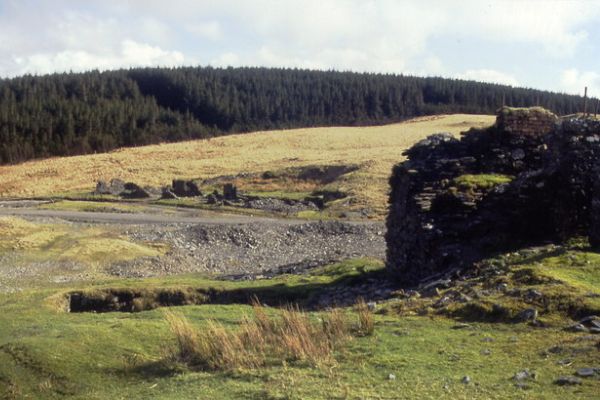 |
Northern Mine Research Society Registered Charity 326704 |
Esgair Hir & Esgair Fraith Mines
 |
Copyright © Chris Andrews and licensed for reuse under this Creative Commons Licence |
The main lode is a fracture zone, up to sixty feet wide in places, which runs east to west on the edge of the Plynlimon Ordovician rocks at their junction with the Silurian. The lead ore occurred in vertical shoots, or pipes, which narrowed at depth and were separated by barren ground.
An outcrop of ore was discovered at Esgair Hir before 1690 and the estate's owner, Sir Carberry Pryse, decided to work it himself. The value of silver in the ore was, however, considered enough to attract the attention of the Society of Mines Royal, which had a royal monopoly to work mines rich in silver or gold. The courts decided in Pryses's favour, however, and he formed a company and began mining, but this proved more expensive than he'd thought.
Pryse died in 1694 and the manager of his old company, William Waller, who was something of a self-propagandist, made grandiose claims for the mine. Waller and Sir Humphrey Mackworth, an industrialist with extensive coal and metal smelting interests at Neath, organised the reformation of the old company as Company of Mines Adventurers of England. This company is said to have won some 2000 tons of ore from Esgair Hir between 1703 and 1708, when it stopped working there.
As a measure of the mine's remoteness, over the winter of 1839-40, Williamson and Eyton, a Flintshire smelting company, employed 99 men to build 4½ miles of road to the mine. They built a large pumping wheel at the mine, with an extensive system of ponds and leats to serve it. Nevertheless their venture ended in 1848.
Williamson and Eyton were followed by a number of underfinanced and fraudulent companies. First came William Francis who got the mine into working order before transferring it to the Welsh Potosi Company. They put up new whims on two shafts, sank Bog Shaft and built a range of buildings on the site. To do this they neglected to pay the miners, who went on strike in 1856. The company next agreed to buy two steam engines for hauling, pumping, crushing and conveying the waggons on an incline to the dressing floors. Despite claims that they were built, there is some doubt as to the veracity of this and the company was declared bankrupt in 1857.
Cardigan Consols began work in the summer of 1858 and had to repair the waterwheel before much could be done and little ore was raised. The next year saw work concentrated on sinking and developing Bog Shaft. Six hundred feet of new pump rods were laid between the waterwheel and shaft, where a whim was built. Other new shafts were sunk, but all failed to find much ore and so the company gave up in 1867.
Between 1872 and 75 the Esgair Hir Mining Company concentrated on the western end of the sett where it used a 20 inch horizontal engine to pump at Engine Shaft. The company reportedly used a boring machine for shaft sinking. Sunk well to west, Shaft Goch had good ore before it ran into an older shaft and the company ruined itself trying to recover the workings.
In 1877 the Cambrian Company used the steam engine to drain the working, but abandoned it when the old waterwheel and long line of pump rods to Engine Shaft had been repaired. No worthwhile ore was found, so the company turned its attention to the mine's eastern end, where the ground between Copper and Eastern Shafts was developed. Some copper ore was won, but it was a time of rapidly falling prices for that metal, so the mine closed.
Between 1886 and 1904 a number of small partnerships worked the mine, presumably stripping ore from old workings and treating dump material.
Further reading:
- Palmer, M. "The Richest in all Wales!" The Welsh Potosi or Esgair Hir and Esgair Fraith Lead and Copper Mines of Cardiganshire (British Mining No.22, 1983)